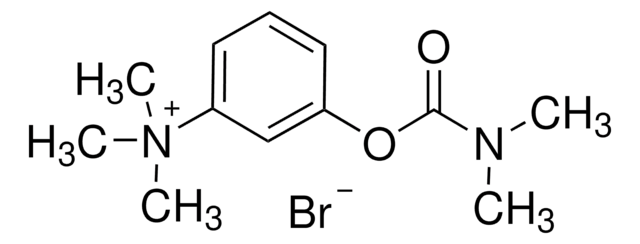N2001
Neostigminbromid
≥98% (HPLC and titration), powder
Synonym(e):
3-(N,N-Dimethylcarbamoyloxy)-N,N,N,-trimethylanilinium bromide, Prostigmine
About This Item
Empfohlene Produkte
Assay
≥98% (HPLC and titration)
Form
powder
Farbe
white
mp (Schmelzpunkt)
175-177 °C (lit.)
Löslichkeit
H2O: 1 g/mL
ethanol: soluble
SMILES String
[Br-].CN(C)C(=O)Oc1cccc(c1)[N+](C)(C)C
InChI
1S/C12H19N2O2.BrH/c1-13(2)12(15)16-11-8-6-7-10(9-11)14(3,4)5;/h6-9H,1-5H3;1H/q+1;/p-1
InChIKey
LULNWZDBKTWDGK-UHFFFAOYSA-M
Angaben zum Gen
human ... ACHE(43)
Suchen Sie nach ähnlichen Produkten? Aufrufen Leitfaden zum Produktvergleich
Anwendung
- to control reaction specificity of acetylcholinesterase in coronal organ of Botryllus schlosseri.
- to study its effects on abnormal contraction of pyloric circular smooth muscle strips (PCSMS).
- to study its effects on depolarization of bag cell neurons.
Biochem./physiol. Wirkung
Leistungsmerkmale und Vorteile
Signalwort
Danger
Gefahreneinstufungen
Acute Tox. 1 Inhalation - Acute Tox. 2 Dermal - Acute Tox. 2 Oral - Eye Irrit. 2 - Resp. Sens. 1 - Skin Irrit. 2 - Skin Sens. 1 - STOT SE 3
Zielorgane
Respiratory system
Lagerklassenschlüssel
6.1A - Combustible acute toxic Cat. 1 and 2 / very toxic hazardous materials
WGK
WGK 3
Flammpunkt (°F)
Not applicable
Flammpunkt (°C)
Not applicable
Persönliche Schutzausrüstung
Eyeshields, Faceshields, Gloves, type P2 (EN 143) respirator cartridges
Analysenzertifikate (COA)
Suchen Sie nach Analysenzertifikate (COA), indem Sie die Lot-/Chargennummer des Produkts eingeben. Lot- und Chargennummern sind auf dem Produktetikett hinter den Wörtern ‘Lot’ oder ‘Batch’ (Lot oder Charge) zu finden.
Besitzen Sie dieses Produkt bereits?
In der Dokumentenbibliothek finden Sie die Dokumentation zu den Produkten, die Sie kürzlich erworben haben.
Kunden haben sich ebenfalls angesehen
Unser Team von Wissenschaftlern verfügt über Erfahrung in allen Forschungsbereichen einschließlich Life Science, Materialwissenschaften, chemischer Synthese, Chromatographie, Analytik und vielen mehr..
Setzen Sie sich mit dem technischen Dienst in Verbindung.










